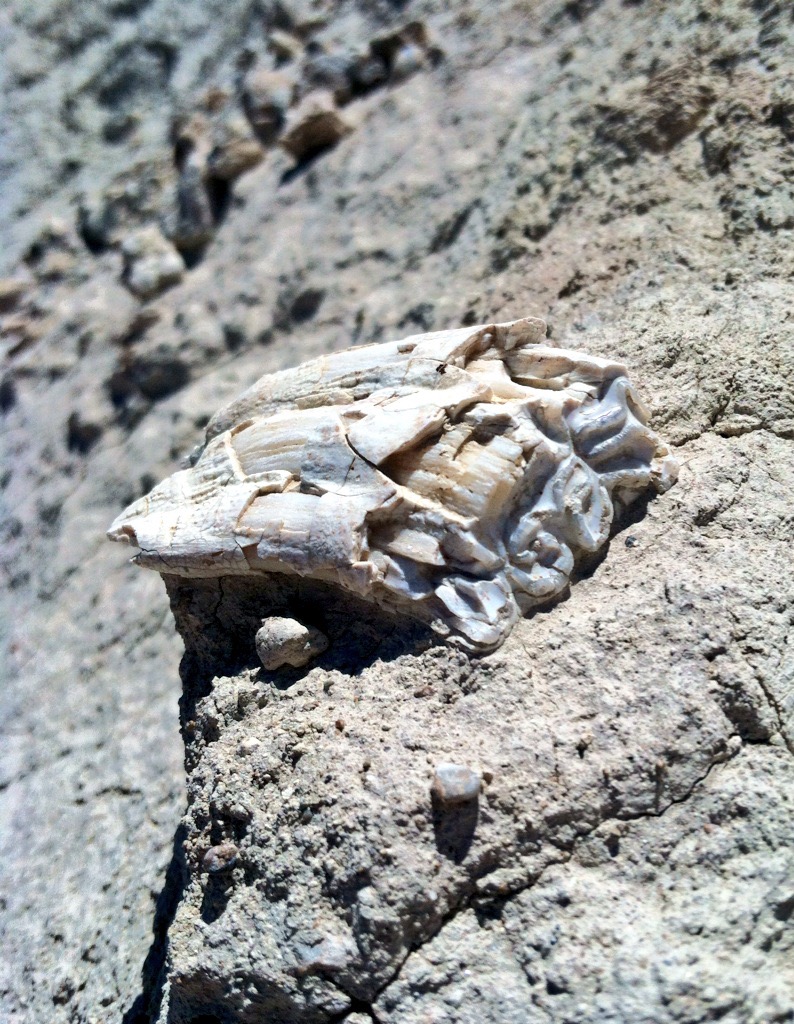Last updated: October 30, 2024
Lesson Plan
What's for Dinner?

Fossil horse tooth at Tule Springs Fossil Beds.
USGS Photo | Kathleen Springer
- Grade Level:
- Lower Elementary: Pre-Kindergarten through Second Grade
- Subject:
- Science
- Lesson Duration:
- 30 Minutes
- Common Core Standards:
- K.W.7, 1.W.7, 2.W.7
- Additional Standards:
- NGSS K-LS1-1: Use observations to describe patterns of what plants and animals (including humans) need to survive.
LS1.A: Structure and Function - Thinking Skills:
- Understanding: Understand the main idea of material heard, viewed, or read. Interpret or summarize the ideas in own words. Applying: Apply an abstract idea in a concrete situation to solve a problem or relate it to a prior experience.
Essential Question
How can we make hypotheses about how ancient animals survived by observing their physical structures?
Objective
Students will observe the shape of animals’ teeth to determine whether they are carnivores or herbivores. Careful observation and hypotheses can help us figure out things we don’t know.
Preparation
Prepare photos, toys, or model replicas of living animals for the review that students can compare to extinct Ice Age animals. Some examples include:
- Cats (domestic cats, mountain lions, jaguars, etc.)
- Dogs (domestic dogs, wolves, coyotes, etc.)
- Horses
- Elephants
- Bears
- Rabbits (jackrabbit, cottontail)
- Cow
- Prehistoric Life of Tule Springs Article Series
-
Pleistocene Animal Jaws & Teeth Supplemental Materials
Materials
Summary of procedures and optional student worksheet for activity.
Download What's for Dinner? Student Worksheet
Procedure
- With the entire class, review the following ideas:
- We can determine what an animal ate by observing the shape of its teeth.
- Scientists that study fossils called paleontologists use visual clues like teeth shape to help determine what long extinct animals ate for food.
- Herbivores, or plant eaters, have strong, flat molars that grind up leaves. Their canine teeth, if they have them, are small.
- Carnivores, or meat eaters, have prominent canine teeth for tearing at meat and usually a limited number of molars.
- Omnivores are animals that eat both meat and plants. They have a combination of sharp front teeth for tearing meat and flat molars for grinding plant materials.
- Show students some examples of living animals and ask them what they think the animal’s diet is. You can do this by doing a raise-your-hand vote, and having some students explain why they think this.
- Explain that this concept can also be applied to extinct animals, and that making careful observations about fossils can give us important clues about how animals survived.
- In small groups or independently, students will log their observations and hypotheses about prehistoric creatures. They can use the optional student worksheet to log these observations and hypotheses.
- Complete a work share out about these observations and hypotheses.
- To close: If time allows, you may close the activity by doing a 3-2-1 exercise. For Kindergarten, this should be done as a class, with the teacher recording on a board or chart paper. After the lesson, have students share:
- 3 things they learned
- 2 things they found interesting that they'd like to learn more about
- 1 question they have
